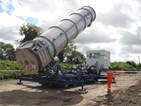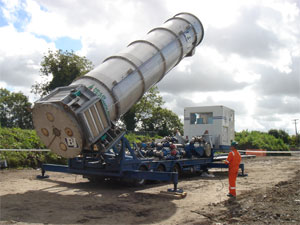BJ Process And Pipeline Services Completes Ethylene Flaring Operation In Germany

 Aberdeen, Scotland - BJ Process and Pipeline Services (BJ PPS) recently assisted a key client with re-commissioning an ethylene pipeline near Leipzig, Germany.
Aberdeen, Scotland - BJ Process and Pipeline Services (BJ PPS) recently assisted a key client with re-commissioning an ethylene pipeline near Leipzig, Germany.
A section of the pipeline 48km (20.8 miles) in length and DN250 (approx. 10") in diameter had been isolated, decommissioned, repaired and pressure tested. After maintenance work was complete, the line was left under a pure nitrogen gas blanket. The client planned to re-commission the section without using pigs as an interface between the nitrogen and ethylene gases, but had to achieve a specification of less than 80 parts per million nitrogen concentration before resuming normal pipeline operations.
Flaring a Mixture of Nitrogen-Ethylene Gas
BJ PPS was contracted to assist with two critical steps in the re-commissioning process. The first involved venting nitrogen gas downstream to move the ethylene/nitrogen interface. The second required flaring the nitrogen/ethylene gas mixture at the interface until the required ethylene pipeline purity was achieved.
For the first phase a ‘T' piece, pressure control valve and temporary piping were tied-in downstream and used to transfer nitrogen gas from the pipeline to the BJ silencer vent. Ethylene gas was then injected into the upstream pipeline at an equal rate to the venting nitrogen to maintain line pressure. Flow rate and pressure drop parameters were controlled to avoid Joule-Thomson chilling effects as 10 000 m3 of nitrogen gas was displace. Noise levels were maintained below 85 decibels.
Mobile Flare Unit Achieves Results
During the early stages of the venting process, BJ's self-erecting variable-tip mobile flare unit was tied into the temporary piping system to prepare for flaring operations. Due to the unit's self-sufficient design, rig-up was completed in less than two hours.
Periodic samples were taken from the venting nitrogen gas stream to check for ethylene content. When ethylene was detected, flow was switched from the silencer vent to the flare unit.
Flaring was controlled at a rate of 300 m3/hr with minimal ethylene concentration present and increased at BJ supervisor discretion upon stabilization. As ethylene content increased, flaring was stepped up until a rate of 500 m3/hr of ethylene was reached. Flaring continued until a nitrogen concentration of less than 20 parts per million was achieved (significantly below the allowable threshold of 80 parts per million). The BJ mobile flaring equipment was then isolated, purged with nitrogen gas and rigged down, allowing normal pipeline operations to resume.
A total of 14, 000 m3 of nitrogen/ethylene gas mixture was flared over a period of 30 hours, with operations completed well within the planned time-frame of three days. "The mobile flare unit has been instrumental in our ability to carry out flaring operations efficiently, with minimal impact on the environment," said Lindsay Link, general manager of BJ PPS. "I'm happy to report this recent flaring operation on an ethylene pipeline in Germany further underscores the effectiveness and versatility of the unit. We look forward to using it to achieve similar results for clients throughout Europe, and internationally," he added.
Clean Burn Flaring Technology
BJ PPS's variable-tip ‘clean burn' flaring technology uses real-time flue gas analysis to achieve complete combustion by automatically regulating waste gas/air mixture ratios, optimizing burner tip gas velocity and maximizing burner tip residence time. As a result, emissions concentrations are significantly below legislative threshold limits. Typical applications include refinery, petrochemical and gas plant shutdowns, tank or ship degassing, pipeline product removal and well testing operations. Over time, BJ PPS has used the system to handle a variety of materials, including natural and sour gas, ethylene, NGLs, LPG and butadiene.
SOURCE: BJ Process and Pipeline Services
